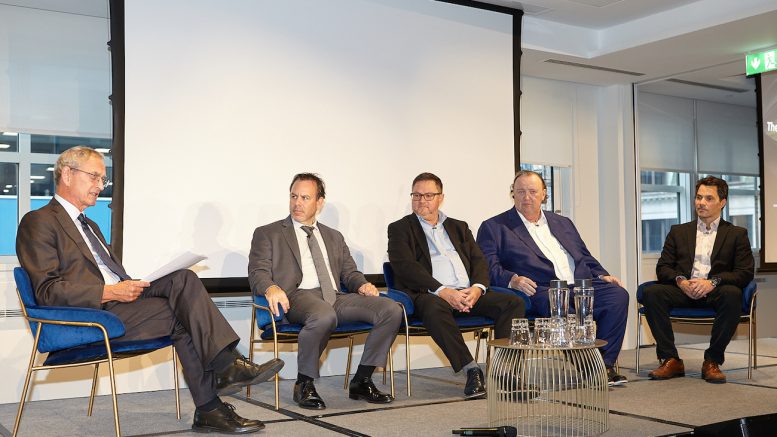As the mining sector continues to face mounting ESG pressures, innovation is becoming more imperative.
But without money to help mining lighten its environmental footprint, it can’t happen, a panel at The Northern Miner’s Canadian Mining Symposium in London, U.K., heard on Oct. 13.
“There’s only two types of projects — the ones you can finance and all the rest,” Sean Roosen, chairman and CEO of Osisko Development Corp. (TSXV: ODV; NYSE: ODV) told a panel sponsored by Dundee Sustainable Technologies and moderated by Chris Hinde, director of Pick & Pen.
“The innovation that we need in this space is making our projects more investible to a lot of pension funds because we need large capital. We are consumers of big capital. And on the technical side the innovation comes slow because, in the mining industry, adoption of technology has been generally expensive and somewhat painful.”
Roosen, chairman of Osisko Gold Royalties (TSX: OR; NYSE: OR) one of the co-founders of the original Osisko Mining, which found and developed the Canadian Malartic mine in Quebec, said some innovation is underway at mines. Ore sorting will cut in half the amount of waste going into the tailings pond at Osisko Development’s Cariboo gold project in B.C., while use of road headers — electric underground tunnelling machines — avoids drilling and blasting. Operations are also using more autonomously operated equipment.
“The problem we have is that the finance world has absolutely no interest in R&D per se, or being part of an investment in a tech case,” he noted. Meanwhile, the engineering and development side is often “oblivious” about approaching and handling the finance side.
“Philip Morris gets an 84 ESG score. Tesla gets a 36, and the companies that supply all the metals to make a Tesla averaged an eight. So somewhere along the line, we are not getting our message across in a manner that’s acceptable.”
Even the application of existing technology in a new setting can be seen as high risk. John McConnell, president and CEO of Victoria Gold (TSX: VGCX), shared his experience developing the Eagle gold mine as the first heap-leach operation in the Arctic.
“Certainly, we had many doubters. but eventually we found Osisko (Gold Royalties) and Orion (Mine Finance),” McConnell said.
“They came in and did a lot of due diligence and, in the end, we were able to convince them that heap leaching in the north wasn’t a problem and they helped us arrange the financing. But in other areas of the operation, say mining as an example, we went with very much tried and true equipment that we knew would work in the Arctic. That made the financing much easier.”
Stephen Mullowney, CEO of TRX Gold Corp. (TSX: TNX; NYSE-AM: TRX) noted that new technology usually needs to be tested in larger mining operations, for example, when a mine using traditional processes runs into problems with their orebody and then looks to new technologies for a solution.
“A single asset producer, a small cap company, they can’t do that. That’s not financeable until it’s proven out through — traditionally — a larger enterprise doing it.”
Communication precedes adoption
Another barrier to innovation is a lack of understanding of new technology.
“I like to look at metallurgical processes that I understand. If I can understand it, then I can sell it,” Mullowney said.
As an innovator that has developed two novel metallurgical processes, Dundee Sustainable Technologies’ president and CEO Jean-Philippe Mai says that far from being a ‘black box,’ the company is very open and takes the time to explain how its technology works.
“We are very aware that adoption comes through understanding.”

Jean-Philippe Mai, president and CEO of Dundee Sustainable Technologies speaks at the Canadian Mining Symposium. Credit: The Northern Miner
In Dundee’s case, all of the “novelty” of its solutions comes from chemistry. Dundee’s CLEVR process extracts gold from ore without using cyanide, which is conventionally used in gold processing but has been banned in some jurisdictions. Its GlassLock process removes and stabilizes arsenic from ore during processing to ensure it can’t be released into the environment.
The processes don’t rely on novel equipment, Mai says — an important point in terms of reducing the risk of adoption. “Everything that you see in our plant is equipment that’s already being used in the mining industry [on a] larger scale or a different application.”
Dundee has two industrial-scale demonstration facilities that have handled hundreds of tonnes of concentrate. But it’s still had trouble reaching mining companies with the message that its processes work.
Perhaps the best way to secure financing for new technology, increase adoption and advance mining’s social acceptance, Roosen said, is to focus on innovation that will move the needle on sustainability.
In fact, Roosen suggested Dundee should market its technology as a water management solution since water is crucial to First Nations communities and to the whole concept of ESG.
“ESG has come along and created this environment where probably the number one R&D technology that needs to be effective is water management,” he said.


Be the first to comment on "CMS: Sustainability is the key to funding innovation, Dundee panel hears"